Credit Risk Management In and Out of the Financial Crisis: New Approaches to Value at Risk and Other Paradigms, 3rd EditionISBN: 978-0-470-47834-9
Hardcover
400 pages
May 2010
 This is a Print-on-Demand title. It will be printed specifically to fill your order. Please allow an additional 10-15 days delivery time. The book is not returnable.
|
||||||
List of Abbreviations xi
Preface xv
Part One Bubbles and Crises: The Global Financial Crisis of 2007–2009
Chapter 1 Setting the Stage for Financial Meltdown 3
Introduction 3
The Changing Nature of Banking 3
Reengineering Financial Institutions and Markets 17
Summary 21
Appendix 1.1: Ratings Comparisons for the Three Major Rating Agencies 23
Chapter 2 The Three Phases of the Credit Crisis 24
Introduction 24
Bursting of the Credit Bubble 24
Phase 1: Credit Crisis in the Mortgage Market 29
Phase 2: The Crisis Spreads—Liquidity Risk 33
Phase 3: The Lehman Failure—Underwriting and Political Intervention Risk 37
Summary 43
Chapter 3 The Crisis and Regulatory Failure 45
Introduction 45
Crisis Intervention 45
Looking Forward: Restructuring Plans 52
Summary 64
Part Two Probability of Default Estimation
Chapter 4 Loans as Options: The Moody’s KMV Model 67
Introduction 67
The Link between Loans and Options 67
TheMoody’s KMV Model 70
Testing the Accuracy of EDFTM Scores 74
Critiques of Moody’s KMV EDFTM Scores 86
Summary 93
Appendix 4.1: Merton’s Valuation Model 93
Appendix 4.2: Moody’s KMV RiskCalcTM 95
Chapter 5 Reduced Form Models: Kamakura’s Risk Manager 98
Introduction 98
Deriving Risk-Neutral Probabilities of Default 99
Generalizing the Discrete Model of Risky Debt Pricing 102
The Loss Intensity Process 105
Kamakura’s Risk Information Services (KRIS) 108
Determinants of Bond Spreads 110
Summary 114
Appendix 5.1: Understanding a Basic Intensity Process 114
Chapter 6 Other Credit Risk Models 117
Introduction 117
Credit Scoring Systems 117
Mortality Rate Systems 121
Artificial Neural Networks 125
Comparison of Default Probability Estimation Models 127
Summary 131
Part Three Estimation of Other Model Parameters
Chapter 7 A Critical Parameter: Loss Given Default 135
Introduction 135
Academic Models of LGD 135
Disentangling LGD and PD 142
Moody’s KMV’s Approach to LGD Estimation 143
Kamakura’s Approach to LGD Estimation 146
Summary 146
Chapter 8 The Credit Risk of Portfolios and Correlations 148
Introduction 148
Modern Portfolio Theory (MPT): An Overview 149
Applying MPT to Nontraded Bonds and Loans 150
Estimating Correlations across Nontraded Assets 152
Moody’s KMV’s Portfolio Manager 153
Kamakura and Other Reduced Form Models 161
Summary 165
Part Four Putting the Parameters Together
Chapter 9 The VAR Approach: CreditMetrics and Other Models 169
Introduction 169
The Concept of Value at Risk 170
Capital Requirements 177
Technical Issues and Problems 180
The Portfolio Approach in CreditMetrics 184
Summary 195
Appendix 9.1: Calculating the Forward Zero Curve for Loan Valuation 195
Appendix 9.2: Estimating Unexpected Losses Using Extreme Value Theory 200
Appendix 9.3: The Simplified Two-Asset Subportfolio Solution to the N-Asset Portfolio Case 202
Appendix 9.4: CreditMetrics and Swap Credit Risk 202
Chapter 10 Stress Testing Credit Risk Models: Algorithmics Mark-to-Future 208
Introduction 208
Back-Testing Credit Risk Models 209
Using the Algorithmics Mark-to-Future Model 215
Stress Testing U.S. Banks in 2009 220
Summary 227
Chapter 11 RAROC Models 228
Introduction 228
What is RAROC? 228
RAROC, ROA, and RORAC 229
Alternative Forms of RAROC 230
The RAROC Denominator and Correlations 235
RAROC and EVA 238
Summary 238
Part Five Credit Risk Transfer Mechanisms
Chapter 12 Credit Derivatives 243
Introduction 243
Credit Default Swaps 244
Credit Securitizations 259
Financial Firms’ Use of Credit Derivatives 269
CDS Spreads and Rating Agency Rating Systems 269
Summary 271
Appendix 12.1: Pricing the CDS Spread with
Counterparty Credit Risk Exposure 272
Chapter 13 Capital Regulation 274
Introduction 274
The 2006 Basel II Plan 275
Summary 296
Appendix 13.1: Loan Rating Systems 297
Notes 303
Bibliography 341
Index 365



